overarching themes
Continue scrolling to read about the meaning behind each illustration. There are additive resources in each segment of the book related to each underlying topic. click on the links to learn more!

On Gender Neutral Names:
Dani is a gender neutral name and I chose it particularly because I wanted to highlight the importance of respecting everyone’s chosen names and pronouns. Though most people aren’t given a gender neutral name, they often choose a name later in life to identify with because they resonate more with it. Gender neutral names are not an often occurrence in Latinx culture, and so I wanted to create a space in which they exist and are shown appreciation.
For more information on gender neutral names and pronouns, here is a resource called “Supporting Chosen Names and Pronouns” on the Diversity & Inclusion; Gender & Sexuality resource page by Johns Hopkins University.
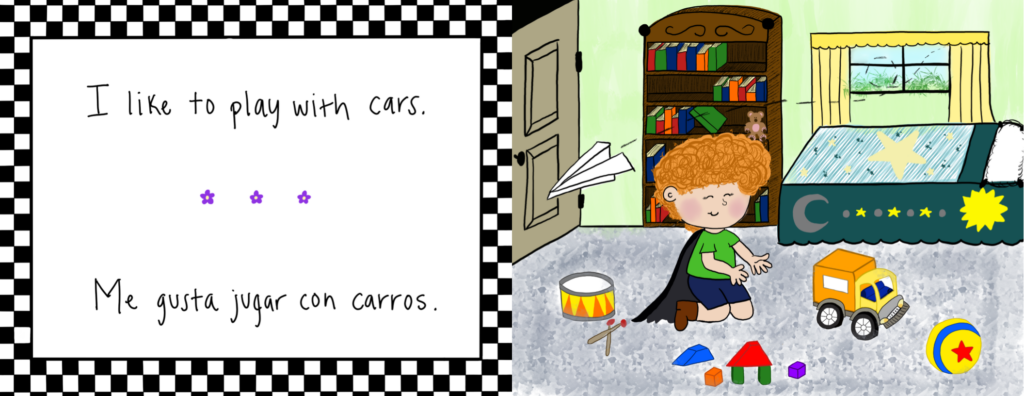

On Gendered Play:
By playing with both trucks and dolls, Dani demonstrates he is enjoying his experience playing with toys that are stereotypically known to be for girls or for boys. Giving our children the freedom and flexibility of being able to choose both, and not one over the other, is important so that they can break the gendered roles imposed on them by the toys they interact with. This way, Dani can learn to create a fusion between masculinity and femininity in the realm of play.
For more information, here is an article that highlights the importance of gender fluidity in the toy industry as well as the importance of allowing our children to explore their acts of play: “Sparkle Unicorns And Fart Ninjas: What Parents Can Do About Gendered Toys” by Anya Kamenetz, Cory Turner
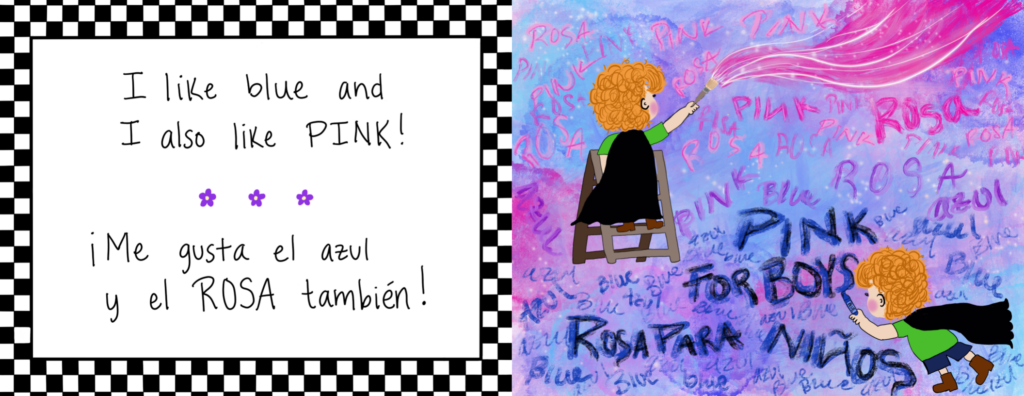
On Gender fluidity:
Here, Dani is expressing his interest in playing with gender fluidity. The portrayal of an abstract blue and pink background represents his imagination and the ways in which he is being confronted by certain gender roles and expectations. Dani is writing in blue “Pink for boys. Rosa para niños” because he is curious about being able to express and explore his feminine side. Slowly, by mixing his inner blues and pinks, he begins blending them into purple. This serves as a metaphor for the intersectionality of his feminine and masculine sides. Confining our children to harmful gendered boxes, such as tethering their gender to certain colors, only limits them from being able to be in tune with their emotions. Showing them that they are free to choose and explore their gender identity allows them to grow more respect and appreciation for gender fluidity, in turn making them a more compassionate human being.
For more resources and an in-depth definition of gender fluidity, here is a resource called The Trevor Project. This is a non-profit Organization that focuses on suicide prevention among the LGBTQ+ youth. They also provide definitions of gender identities and detailed explanations on how to begin understanding them.
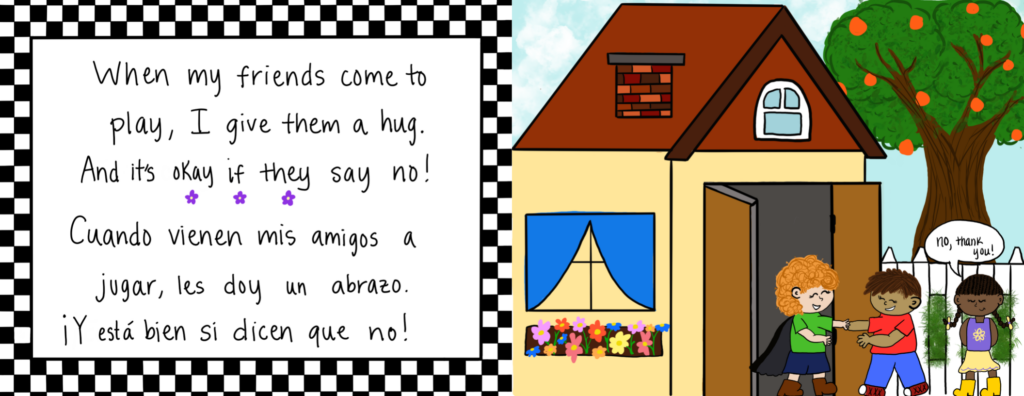 On Consent:
On Consent:
By recognizing that not all people are comfortable receiving hugs, Dani shows that he understands that everyone has different boundaries in regards to physical touch. Here, I depicted two boys showing affection, while the little girl respectfully declines the hug. This moment teaches our reader that it’s acceptable for boys to show affection with each other, especially since this is a stigmatized action. This also teaches the reader about young girls learning how to say “no.” I wanted to particularly highlight the little girl declining physical touch because of the rise in gender-based violence towards women. It’s important to teach our children about consent so that they grow to learn about their own personal boundaries as well as respecting others’ boundaries.
A resource that could teach you more on how to teach children about consent is this organization called Safe Secure Kids. This is an online resource that provides parents, caregivers, and teachers with the tools they need in order to communicate to children about safety in regards to child abuse and harassment.
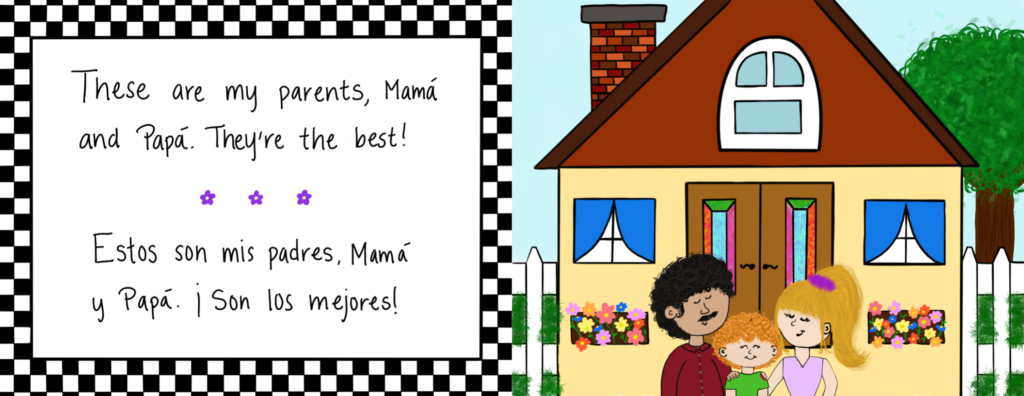
On Parenting:
This illustration serves as an introduction to Dani’s family dynamic. Here we see that his parents, Mamá and Papá, are standing behind him with their hands on his shoulders. This depiction in front of their home demonstrates that their family is loving and supportive. The scene also shows that the environment Dani’s parents have created for him is a healthy one. In order for children to feel safe with exploration of gender and relationships, they must feel supported by their family. It is important to remain patient and graceful with children in their early learning stage because it’s the phase of growth where they begin affiliating themselves with certain identities and developing their moral compass.
For more resources on parenting, refer to Healthy Families America and Encompass Connection Center. These are organizations that can help guide parents and guardians on parenting techniques, parenting styles, and ways in which they can be the best possible parents for their children.
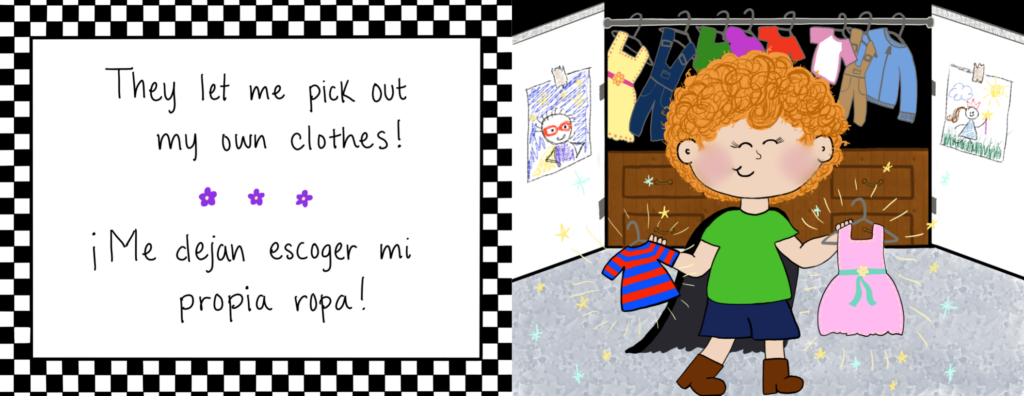
On Freedom of Expression:
Here, Dani is showing his appreciation for his parents for allowing him to pick out his own clothes. Through choosing the ways in which he can express himself, he is able to build his comfortability with himself and his identity. A major component of a child being able to express themselves are parents who allow their children to do so. Without parent support, it inhibits children from learning how to maneuver the challenges faced when it comes to freedom of expression. Here, we see that his parents provide a wide range of clothing for Dani to choose from, providing him the agency to explore his gender identity through clothing, thus allowing him the freedom to express himself in his own ways.
To help understand the effect clothing has on children, reference this article called Understanding The Psychology of Clothing in Children – A Guide for Parents. Additionally, here is a children’s book worth looking into in regards to children’s choices and clothing; it’s called Fred Gets Dressed by Peter Brown.
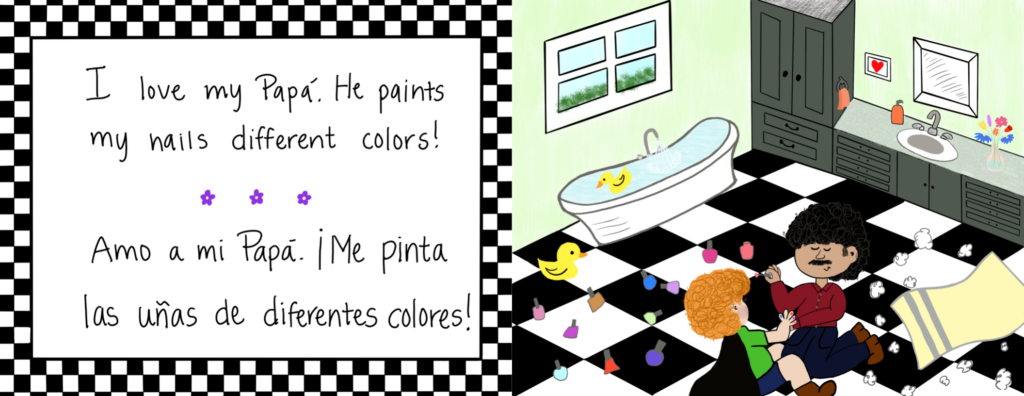
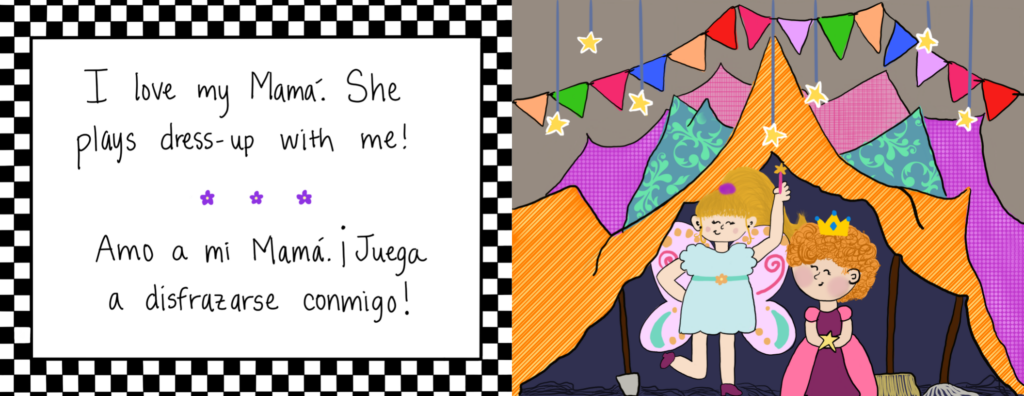
On Expression of Femininity:
In these two scenes, Papá is painting Dani’s nails and Mamá is playing dress-up with him. These moments are to showcase the ways in which parents can be supportive of expressing and practicing femininity with their children. In Latinx culture, many fatherly figures are Machistas in that they refuse to allow their sons show any signs of feminine affiliation. Here, by painting Dani’s nails, Papá is demonstrating that he is willing to explore his femininity alongside Dani. This shows that parent figures can be capable of gently inviting femininity into their own lives as well as their children’s lives. These illustrations show the harmony that can exist within the intersectionality of family dynamics and feminine expressivity.
To read more about the importance of playing dress-up with our children, visit this article titled “Playing Dress-up: Benefits, How to Start, and Tips.”
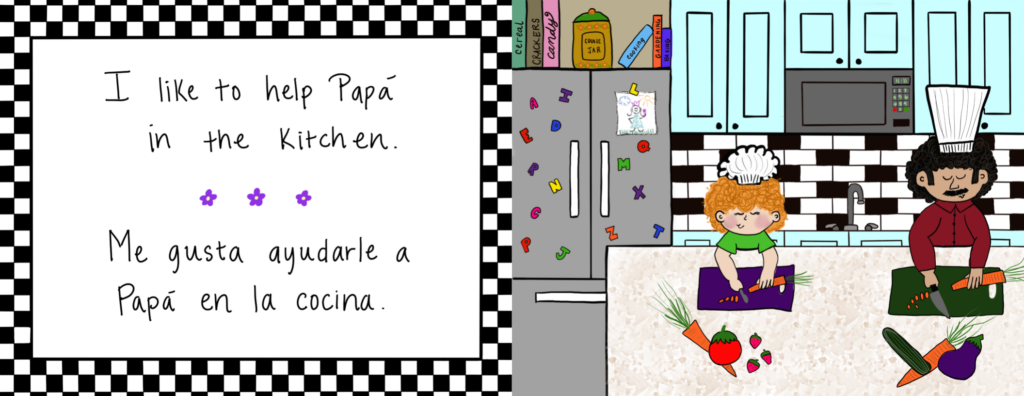
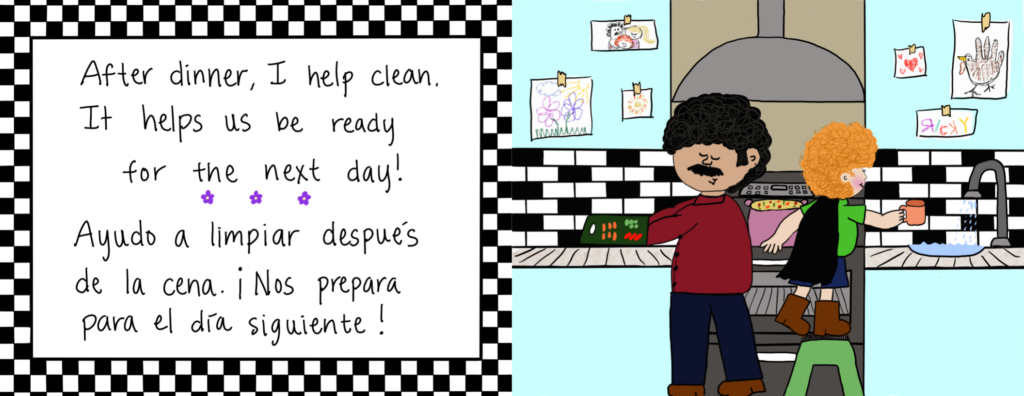
On Domestic Work:
A common stereotype in Latinx households is tethering women to domestic labor, such as child care, cooking, cleaning, etc. Here, Dani and Papá are breaking that stereotype of only women dealing with these types of responsibilities. By being the one in the kitchen and cleaning after himself, Papá sets an example for Dani and shows him that men/boys should also be expected to help around the house and carry out duties that are typically expected of women. This lesson plays an important role in teaching children how to be respectful of this type of labor and validating it as a dignified form of work.
For more information on Domestic Work and Worker Organizing, reference this digital timeline as it unravels its history along with general definitions surrounding domestic labor.

On Gendered Responsibilities/Chores:
Another common stereotype in Latinx culture is men doing yard work and deeming it as the “tougher” and more “masculine” chore of the house. By switching the stereotypical roles of “women in the kitchen” and “men doing the yard work,” Mamá and Papá show Dani that breaking these gender expectations is an acceptable thing to do. Normalizing that all gender identities are capable of executing these gendered responsibilities demonstrates a healthy way of breaking away from harmful, stereotypical gender norms and adopting a more inclusive way of redefining them.
In this New York Times article, “The Household Work Men and Women do, and Why” by Francesca Donner, gender roles and domestic labor are analyzed in the ways they are characterized as either masculine and feminine, and why. It is an interesting read and helps in understanding the role gender plays in the realm of domestic work. Another recommended article, specifically regarding gendered roles in domestic work in Latinx culture, is “Opinion: Gender Inequality in Latino Households.”
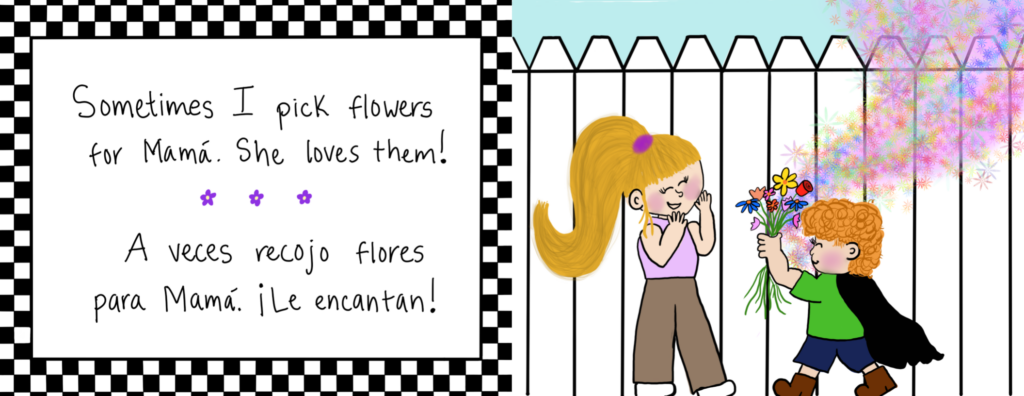
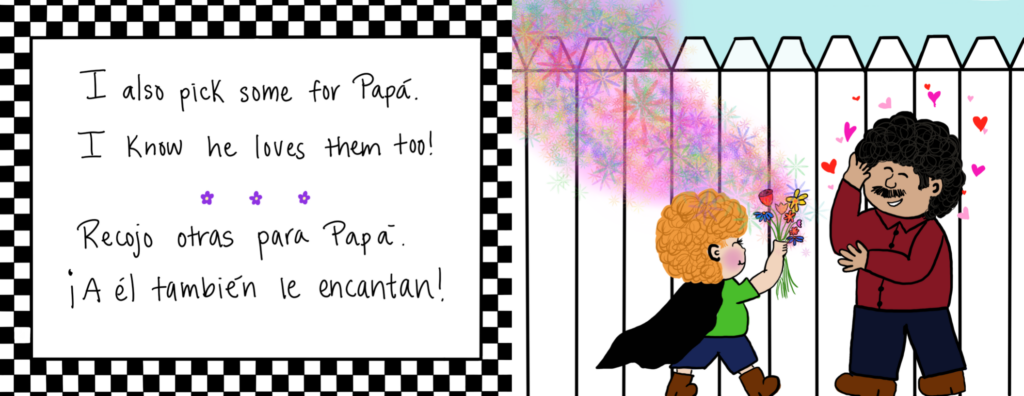
On Gender equality:
By picking flowers for both Mamá and Papá, Dani shows that he knows both men and women are equally deserving of receiving flowers. This serves as a minor-scale metaphor to show that equality across genders can be expressed even in the smaller things in life. The appreciation Dani shows for his parents also tells the reader that he is grasping the concept of treating all people equally.
A couple of children’s books that address the topic of gender equality that are worth reading are:
My Shadow Is Purple by Scott Stuart
Pink Is For Boys by Robb Peralman
Being You: A First Conversation About Gender by Jessica Ralli and Megan Madison
Julián Is A Mermaid by Jessica Love
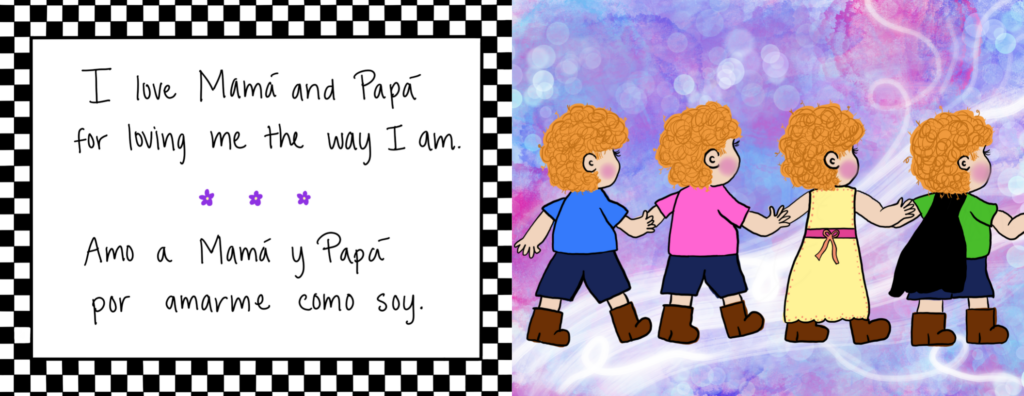
On Self-acceptance:
Here, the illustration depicts all versions of Dani holding hands in solidarity. This represents his self-acceptance in that he acknowledges his femininity, masculinity, and everything in between. The abstract background, once again, represents his imagination and his mental space. Unlike the first time this type of setting appears in the book (the pages about gendered colors), the color purple is more prominent, meaning that he is beginning to create a bridge between the two identities, slowly merging them together. This self-acceptance contributes to the development of self-confidence and self-esteem, allowing our kids to grow and feel more comfortable in their own skin.
For more information on supporting self-acceptance and introducing conversations on gender, reference this article called “Ways to Expand a Child’s Thinking About Gender Identity” and this parent guide on gender-geared conversations; “An age-by-age Guide to Talking to Your Kids About Gender.”
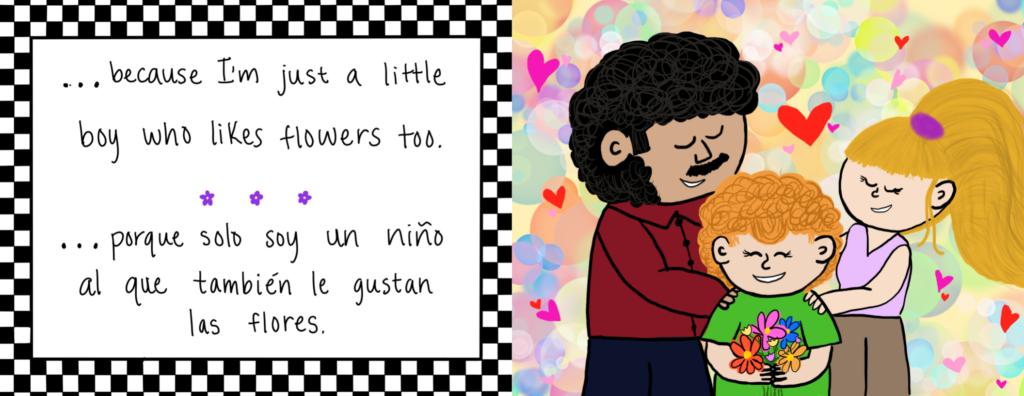
On Family DynamicS:
The end page represents the unification of a family and the ideal result of supporting our children every step of the way in regards to their self-discovery process. The background is representative of a rainbow, symbolizing the celebration of all genders, allowing happiness to flow in abundance. The importance of teaching our children to be respectful and loving towards all gender identities ultimately allows them to flourish into kind human beings. Through supporting our children, allowing them to explore the crossroads of femininity and masculinity, and embracing their curiosity, we can work towards achieving a more unified effort in combating Machismo and its consequences.
For more information on how to combat Machismo inside the home, read this article called “How Are You Combating Toxic Masculinity in Your Household.”